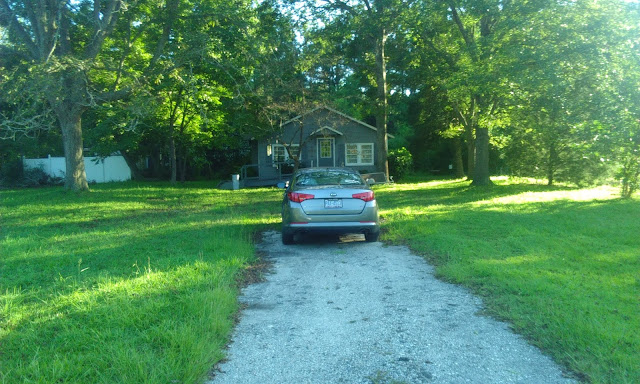Let's start at the front porch. The tree is a mostly dead dogwood which a friend is going cut down for us. We want to open up the canopy so that we can plant "flowery things" for mom. I would like to extend the driveway up closer to the ramp. I would also like a gravel area for sitting...room for company since we don't have much room inside for entertaining.
Scanning to the right (eastward). This is the largest lawn area. It is shaded by a very large pecan tree and two other dogwoods. Converting this to food production will require strategic planning so that it "looks pretty" for mother.
The bushes under the window are gardenias. Momma wants more so learning to propagate them would be helpful. Back and to the left of the corner of the house you can see the trunk of The Great Leaning Pecan Tree. The row of evergreen bushes in the distance are the back-neighbors boundary markers.
Spinning around (don't get dizzy!) to the west, you see another gardenia bush on the corner of the house. Beyond is one of the oak trees, the "Christmas Tree" and beyond that the annual garden.
Scanning to the right again, the two other oak trees. We have been advised to have the one in the foreground removed. If we can get it done affordably it would open the tree canopy so we could get more understory plants growing.
Once more..to the right and back almost to the driveway, another section of lawn and a mulberry. Care needs to be taken in this area as the water line runs up this side. The water line is fairly close to the surface.
Okay, next, let's walk down the ramp to see what is just around the corner of the house.
Here is a little "secret garden" tucked into a niche. Along the house (right side of picture) are hydrangeas and azaleas. There is a chain link fence but no gate (which is a total pain). The brown pile is pecan branches that have fallen. The tree is pecan #3. This area gets only a little sun.
Okay, now for a view from a different angle: the end of the driveway (left to right or east to west).
The white fence was put up by the back neighbor to hide our "junk".
The ditches were glysophated by friends trying to be helpful since I can't keep the ditches cleaned out. In the last picture where you see overgrowth in the ditches is the neighbor's ditch.
Now, standing at the NE corner of the property looking south. In the foreground are my rugosa roses which are just starting to take off after 4 years. I had hoped for a hedge of them and then to build off that with fruit trees and herbs and other food plants.
The southeast section of the property. The posts were going to be for muscadines. The muscadine vines did not survive and the posts didn't get cemented in. Now, two volunteer sweetgums make it necessary to move the muscadine trellis a little north. On the right along the fence are knockout roses. On the left back are the blackberry bushes.
The blackberries have done very well. I have a couple cattle panels and this Fall will use them to trellis the bushes so it will give some control and make harvesting easier.
The elderberry forest! There are mulberries in there, too. I totally failed to account for mature size! Oh my. I am hoping to relocate some or all of the elderberries to the southwest section. That will make it possible to net them and improve harvest.
The black vinyl tarp covers my rabbits/duck-geese night pen. The tree to the left is the camellia under/around pecan #4. Both provide critical temperature control for the rabbits.
A portion of the yard behind the house is fenced for our dogs. I want to fence the east and west thirds for duck-geese pasturing and leave the front center unfenced. It would be nice to have some flowering bushes along this fence...perhaps some gardenias to add fragrance as well.
Corner of the fenced area: there is a volunteer pecan which I want to remove. Then, three mulberry trees in a row along my southern property line.
Beyond the mulberries and still along the southern boundary, my untamed area. Cannas and weeds rule here and filter our laundry greywater.
On the other side are some bush willow in need of rescue.
From the southwest corner, you see the untamed area merging with the garden. The butternut squash vines going crazy over all. Harvest should be interesting!
The grassy line on the left is where I want to move the elderberries. A few starts have been planted in the foreground area.
Here are pictures of the annual garden area. Eventually, I want to have it all covered with wood chips.
Just right of center is a sapling peach tree. I am going to try growing some from pits...we love peaches.
And lastly, are the Santa Rosa Plums located in the northwest section. They flower but so far no fruit. I would like to cover in wood chips and add perennials and annuals to this area.
There is an antique rosebush near this tree and shaded by it. It is losing the battle against some other plant trying to overgrow it. I need to propagate it quick.
That concludes the tour. The souvenir shop is closed but we do have duck eggs available.

































